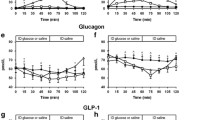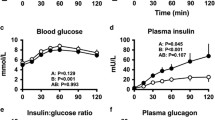Summary
The response of serum gastric inhibitory polypeptide (GIP), serum gastrin, and blood glucose to a mixed liquid test meal with a low glucose load was measured in seven controls, in each of five patients after B II resection and proximal duodenopancreatectomy (PDP), and in three patients after jejunoileal bypass. The gastrin and glucose levels behaved as expected. However, in contrast to previously published data with higher glucose loads the integrated GIP response was slightly decreased after B II resection and significantly decreased not only after jejunoileal bypass but also after PDP. Subsequently we studied postprandial GIP release after test meals containing a low and a high glucose load in each of three controls and three patients after PDP. The results confirm a discrepant behavior of GIP release in dependence on the glucose content of the test meal after PDP compared to the controls. The hypothesis is discussed that these results reflect a special dose-effect relationship between glucose and GIP release in man.
Zusammenfassung
Bei sieben Kontrollen, jeweils fünf Patienten nach B II-Resektion bzw. proximaler Duodenopankreatektomie (PDP) und drei Patienten nach jejunoilealem Bypass wurde die postprandiale Freisetzung von gastric inhibitory polypeptide (GIP), Gastrin und Glucose nach einer flüssigen Testmahlzeit mit einem niedrigen Glucosegehalt gemessen. Die Gastrin- und Glucosespiegel verhielten sich wie erwartet. Im Gegensatz zu früher publizierten Daten mit einer höheren Glucosegabe war die GIP-Freisetzung jedoch nach B II-Resektion gering und nach PDP signifikant erniedrigt. Nachfolgend wurde die postprandiale GIP-Freisetzung nach einer Testmahlzeit mit einem niedrigen und hohen Gehalt an Glucose vergleichend jeweils bei drei Kontrollpersonen und drei Patienten nach PDP untersucht. Die Ergebnisse bestätigen ein diskrepantes Verhalten der postprandialen GIP-Freisetzung in Abhängigkeit von dem Glucosegehalt der Testmahlzeit nach PDP im Vergleich zum Kontrollkollektiv. Die Hypothese wird diskutiert, daß diese Ergebnisse Ausdruck einer spezifischen Dosis-Wirkungs-Kurve zwischen Glucosegabe und GIP-Freisetzung beim Menschen sind.
Similar content being viewed by others
References
Becker HD, Smith HJ, Börger HW, Schafmeyer A (1978) Role of the small bowel in regulating serum gastrin and gastric inhibitory polypeptide (GIP) levels and gastric acid secretion. Adv Exp Biol 106:105–110
Becker HD (1980) Hormonal changes after gastric surgery. In: Creutzfeldt W (ed) Gastrointestinal hormones, vol 9. Saunders, London Philadelphia Toronto, pp 755–772
Besterman HS, Sarson DL, Blackburn AM, Clearly J, Pilkinton TRE, Bloom SR (1978) The hormone profile in morbid obesity and following jejuno-ileal bypass. Scand J Gastroenterol [Suppl 49] 13:15
Börger HW, Schafmeyer A, Becker HD (1980) Release of gastrointestinal hormones in postgastrectomy patients with the dumping syndrome before and after restoration of duodenal passage. In: Creutzfeldt W (ed) The entero-insular axis. Karger, Basel, pp 289
Clauss G, Ebner H (1971) Grundlagen der Statistik, table 6. Deutsch, Frankfurt
Creutzfeldt W, Ebert R, Arnold R, Frerichs H, Brown J (1976) Gastric inhibitory polypeptide (GIP), gastrin and insulin: response to test meal in coeliac disease and after duodenopancreatectomy. Diabetologia 12:279–286
Ebert R, Creutzfeldt W (1978) Aspects of GIP pathology. In: Bloom SR (ed) Gut hormones. Livingstone, Edinburgh, pp 294–300
Ebert R, Finke U (1978) Gastric inhibitory polypeptide (GIP). Z Gastroenterol 16:311–316
Ebert R, Frerichs H, Creutzfeldt W (1978) Dose response relationship between oral glucose load and the serum levels of immunoreactive insulin and gastric inhibitory polypeptide in normals and obese subjects with pathological glucose tolerance. Acta Endocrinol [Suppl] 212:105
Ebert R, Creutzfeldt W (1980) Gastric inhibitory polypeptide. In: Creutzfeldt W (ed) Gastrointestinal hormones, vol 9. Saunders, London Philadelphia Toronto, pp 679–698
Greenwood FC, Hunter M (1969) The preparation of131J-labelled human growth hormone of high specific radioactivity. Biochem J 89:14–123
Klapdor R, Bösenberg G (1980) Pankreasfunktionstest als Screeningverfahren für die klinische Pankreasdiagnostik. Ärzt Lab 26:123–128
Polak JM, Bloom SR, Kuzio M, Brown JC, Pearse AGE (1977) Cellular localization of gastric inhibitory polypeptide in the duodenum and jejunum. Gut 14:284–288
Ralston A, Wief HS (1972) Mathematische Methoden für Digitalrechner. Oldenbourg, München Wien
Schattenmann G, Ebert R, Creutzfeldt W, Sievert JR (1981) Die Bedeutung des Duodenums und Jejunums für die nahrungsinduzierte GIP-Freisetzung. Langenbecks Arch Chir [Suppl] 81:141–145
Stock KP, Schenk J, Schmack B, Domschke W (1981) Funktions-„Screening“ des exokrinen Pankreas. Dtsch Med Wochenschr 106:983–987
Thomas FB, Shook DF, O'Dorisio TM, Cataland S, Mekhijan HS, Caldwell JH, Mazzaferri EL (1977) Localization of gastric inhibitory polypeptide release by intestinal glucose perfusion in man. Gastroenterology 72:9–54
Thomford NR, Sirinek KR, Crockett SE, Mazzaferri EL, Cataland S (1978) Gastric inhibitory polypeptide. Response to oral glucose after vagotomy and pyloroplasty. Arch Surg 109:177–182
Author information
Authors and Affiliations
Rights and permissions
About this article
Cite this article
Klapdor, R. Release of gastric inhibitory polypeptide (GIP) and gastrin after a test meal with a low glucose load in patients after B II resection, proximal duodenopancreatectomy (PDP) and jejunoileal bypass. Res. Exp. Med. 181, 11–18 (1982). https://doi.org/10.1007/BF01850985
Received:
Accepted:
Issue Date:
DOI: https://doi.org/10.1007/BF01850985




